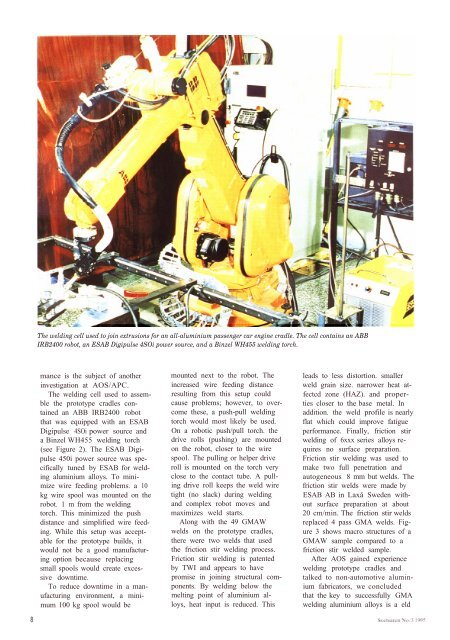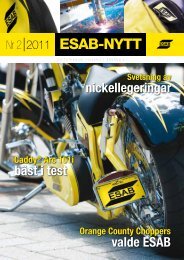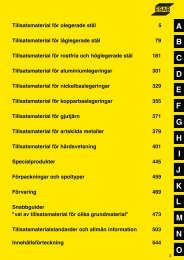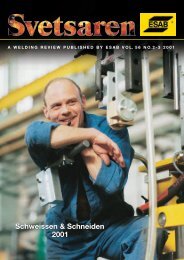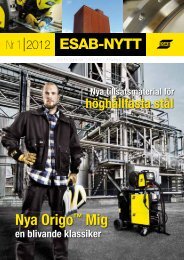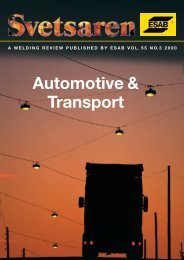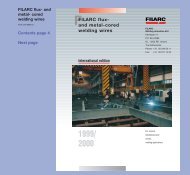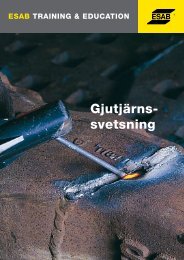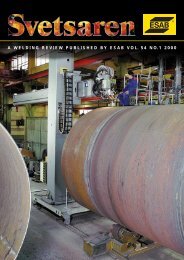Challenges of Welding Aluminium Alloys for Automotive ... - Esab
Challenges of Welding Aluminium Alloys for Automotive ... - Esab
Challenges of Welding Aluminium Alloys for Automotive ... - Esab
Create successful ePaper yourself
Turn your PDF publications into a flip-book with our unique Google optimized e-Paper software.
The welding cell used to join extrusions <strong>for</strong> an all-aluminium passenger car engine cradle. The cell contains an ABB<br />
IRB2400 robot, an ESAB Digipulse 4SOi power source, and a Binzel WH455 welding torch.<br />
mance is the subject <strong>of</strong> another<br />
investigation at AOS/APC.<br />
The welding cell used to assemble<br />
the prototype cradles contained<br />
an ABB IRB2400 robot<br />
that was equipped with an ESAB<br />
Digipulse 4SOi power source and<br />
a Binzel WH455 welding torch<br />
(see Figure 2). The ESAB Digipulse<br />
450i power source was specifically<br />
tuned by ESAB <strong>for</strong> welding<br />
aluminium alloys. To minimize<br />
wire feeding problems. a 10<br />
kg wire spool was mounted on the<br />
robot. 1 m from the welding<br />
torch. This minimized the push<br />
distance and simplified wire feeding.<br />
While this setup was acceptable<br />
<strong>for</strong> the prototype builds, it<br />
would not be a good manufacturing<br />
option because replacing<br />
small spools would create excessive<br />
downtime.<br />
To reduce downtime in a manufacturing<br />
environment, a minimum<br />
100 kg spool would be<br />
mounted next to the robot. The<br />
increased wire feeding distance<br />
resulting from this setup could<br />
cause problems; however, to overcome<br />
these, a push-pull welding<br />
torch would most likely be used.<br />
On a robotic push/pull torch. the<br />
drive rolls (pushing) are mounted<br />
on the robot, closer to the wire<br />
spool. The pulling or helper drive<br />
roll is mounted on the torch very<br />
close to the contact tube. A pulling<br />
drive roll keeps the weld wire<br />
tight (no slack) during welding<br />
and complex robot moves and<br />
maximizes weld starts.<br />
Along with the 49 GMAW<br />
welds on the prototype cradles,<br />
there were two welds that used<br />
the friction stir welding process.<br />
Friction stir welding is patented<br />
by TWI and appears to have<br />
promise in joining structural components.<br />
By welding below the<br />
melting point <strong>of</strong> aluminium alloys,<br />
heat input is reduced. This<br />
leads to less distortion. smaller<br />
weld grain size. narrower heat atfectcd<br />
zone (HAZ). and properties<br />
closer to the base metal. In<br />
addition. the weld pr<strong>of</strong>ile is nearly<br />
flat which could improve fatigue<br />
per<strong>for</strong>mance. Finally, friction stir<br />
welding <strong>of</strong> 6xxx series alloys requires<br />
no surface preparation.<br />
Friction stir welding was used to<br />
make two full penetration and<br />
autogeneous 8 mm but welds. The<br />
friction stir welds were made by<br />
ESAB AB in Laxå Sweden without<br />
surface preparation at about<br />
20 cm/min. The friction stir welds<br />
replaced 4 pass GMA welds. Figure<br />
3 shows macro structures <strong>of</strong> a<br />
GMAW sample compared to a<br />
friction stir welded sample.<br />
After AOS gained experience<br />
welding prototype cradles and<br />
talked to non-automotive aluminium<br />
fabricators, we concluded<br />
that the key to successfully GMA<br />
welding aluminium alloys is a eld<br />
8


